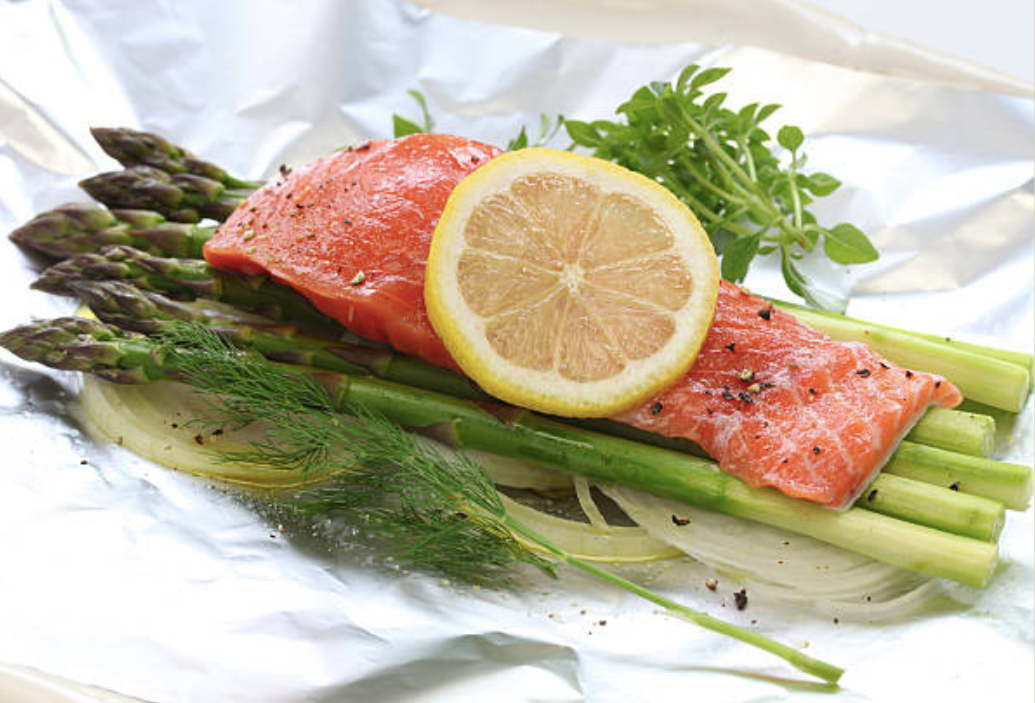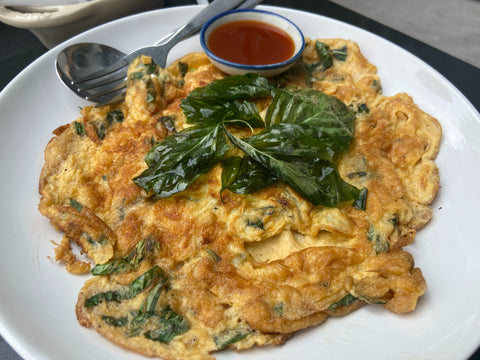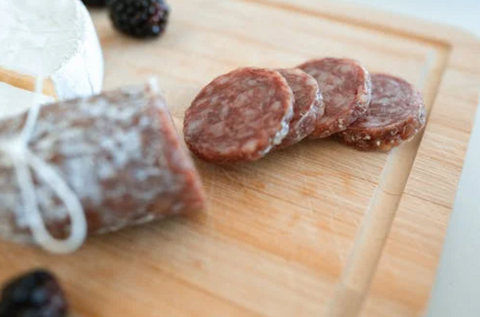Salmon en Papillote is a French dish in which the salmon is cooked in a packet of parchment paper. The package traps moisture, so the fish cooks in its juices and flavors from herbs, shallots, lemon, and butter.
It's a versatile dish that can be used with other fish, vegetables, and aromatics.
The best part is that it is an easy way to cook salmon when you don't want to turn on your oven.
- Salmon en Papillote (in the style of the French Parchment paper) is a method of cooking in which the food is put into a folded pouch or parcel and then baked.
- The packet is typically made from folded parchment paper, but other materials may be used, such as a paper bag or aluminum foil. The parcel holds in moisture to steam the food.
Foods cooked en Papillote are often sliced vegetables (such as zucchini, carrots, tomatoes, etc.), but fish and poultry can also be prepared in this manner. The food may include seasonings such as herbs, spices, and liquid; it is wrapped tightly in the paper or other wrapping and baked.
"En papillote" should not be confused with "al cartoccio" (Italian for "in a parcel") in Italian cuisine, where a similar method is used for cooking fish and vegetables.
Meaning of Salmon en Papillote
If you've ever ordered salmon en papillote in a restaurant, you've probably wondered what the heck "en papillote" means. It sounds like a fancy French term for something complicated that requires expensive ingredients.
In reality, "en papillote" is a fancy French term for cooking foods in parchment packets. And it's super easy to do at home!
The Basics of Cooking en Papillote
First things first: What (or rather who) is Papillon? You're on the right track if you're thinking of the dog breed. Papillon means "butterfly" in French and refers to how the finished dish looks like a butterfly or moth when it's opened up.
If you've never cooked en Papillote before, here are the basics:
Choose your ingredients: The beauty of this method is that it's tough to mess up! You can choose whatever vegetables you want (asparagus and mushrooms are both excellent options), plus any seasonings and herbs you prefer. You can also swap the salmon out for another protein, like scallops or chicken.
Prepare your packet: Cut a piece of parchment paper into a large heart shape (or fold it in half and cut into a.
Salmon en Papillote is made up of:
Salmon en papillote is a French cooking method that involves wrapping food in parchment paper and baking it. It's a great way to get perfectly cooked fish, as the steam created inside the packet allows the salmon to cook without drying out.
To make salmon en papillote, you'll need:
- Parchment paper
- Salmon fillets
- Vegetables
- Seasonings
Salmon Papillote is healthy seafood
Salmon en papillote (pah-pee-YOHT) comes from the French Papillon, meaning "butterfly." In a parchment paper envelope, the cooking technique is also known as al cartoccio in Italy and al Horno de papel in Spain. It may sound fancy, but it's one of the easiest methods for making restaurant-quality fish at home.
The Basics
Salmon en papillote is a healthy, low-fat method for cooking fish and other delicate seafood.
The technique involves wrapping seasoned food in a parchment paper packet or aluminum foil then baking it. This allows the food to steam in its juices and absorbs flavors from seasonings and aromatics inside the packet.
Salmon filets are often used, but other meaty fish like red snapper or halibut can also be prepared en Papillote. A similar technique can be used with shrimp, scallops, and mussels.

How to done en Papillote
En papillote ("in parchment") is a method of cooking in which the food is put into a folded pouch or parcel and then baked. The parcel is typically in the shape of a heart, but other forms are also sometimes used. The pouch is generally made from folded parchment paper, but other materials may be used, such as a paper bag or aluminum foil.
- The pouch is designed to allow steam to circulate within it and cook the food evenly, which happens when the water in the food turns to steam.
- However, the food inside may not necessarily be fully cooked by this method and must therefore be checked with a fork or knife before serving. If more cooking is needed, the packet can be returned to an oven for further heating.
En papillote was once considered a means of weight control because of its perceived health benefits over frying, but further research has disproved this theory.
The technique may also add aesthetic appeal by presenting all the ingredients together when served.
Three steps in preparing Papillote
Clean the sole. You can use a knife to remove the fins from the sides of the sole, but it is not necessary. The fins are edible and part of the experience. Dry with a paper towel.
The fish should be dry before you start. Place on a sheet of parchment paper (or aluminum foil) and season both sides with salt and pepper.
Add lemon slices, herbs, butter, or olive oil to your fish before sealing your Papillote. For vegetables, include seasonings such as salt and pepper, herbs, garlic, and butter or olive oil. If you are using vegetables that take longer to cook than the fish, consider arranging the vegetables in a bed beneath your fish to cook evenly together.
En Papillote is a moist heat method
Yes, en papillote is a moist heat method. It means wrapping food in a paper or foil packet before cooking it.
It is typically used for fish and vegetables, though chicken and other meats can also be cooked en Papillote. The food steams in its juices, and the packet traps in all of the flavor, moisture, nutrients, and aromatics that would otherwise escape during the cooking process.
- En papillote is a moist heat method. En papillote, French for parchment, involves cutting out a heart shape from parchment paper. The center is filled with the meat of your choice and vegetables, then folded over and sealed with a bit of water.
- Next, the package goes into the oven and steam cooks the food inside. Once the food is done cooking, the diner opens the box and enjoys it.
In comparison, roasting is a dry heat method where hot air surrounds the food. Dry heat cooking methods include grilling, broiling, baking, roasting, and sautéing.
Salmon en Papillote with vegetables
Preheat oven to 450°F. Cut two 12-inch squares of parchment paper. Place one salmon fillet in the center of each square. Spread an equal amount of lemon juice over both fillets.
- Divide the vegetables, divide them equally between the two fillets, and arrange them on top. Sprinkle with salt and pepper. Fold each parchment square in half to shape like a half-circle. Starting from the center at the fold, make small overlapping folds along the edges to seal the packets completely.
Place each packet on a baking sheet and bake for 10 minutes or until salmon is cooked through and vegetables are tender.
Good sides of Salmon en Papillote
The most significant advantage of cooking salmon en papillote is that you can carefully control the cooking environment. You can add sauces and seasonings that would otherwise burn or boil away, you can create an intensely moist climate, and of course, you can cook one portion at a time in a way that's convenient for serving.
- The most significant disadvantage is that there's no browning. Some people prefer their salmon a little more done than others, and some like the texture of browned fish better than poached fish.
- As far as sides go, I'd say that anything you could serve with poached salmon will go just fine. Asparagus has always been my favorite side to serve with poached fish because it's mild enough not to compete with delicate flavors and has a very complimentary texture.
- Alternatively, any salad goes well with poached salmon; I particularly like a green salad with lemon vinaigrette. Finally, rice would be an obvious choice; try a saffron rice pilaf if you want something special.
The flavors which go best with Salmon en Papillote
The fact that the fish cooks in its juices mean that you can use just about any flavor you like. The key is to add the ingredients to the salmon before folding it up in the parchment paper to release the flavors during cooking.
We love adding a squeeze of lemon or lime juice, or maybe a spoonful of prepared salsa, along with herbs and spices such as parsley, chives, dill, cilantro, basil, oregano, black pepper, or sea salt flakes. We often add thinly sliced onion and red bell pepper for crunch.
You can also add some butter or oil to keep the fish from sticking to the parchment paper and prevent it from drying out too much during baking.

The popularity of Salmon en Papillote
The popularity of salmon en papillote is no surprise. This method of steaming fish in parchment paper is one-step cooking and cleaning. First, season the fish with salt and herbs and put it in the oven to bake. When it's done, you have moist, tender fish that's ready to eat and easy to clean up after.
You can use any fish for this simple preparation, but I especially like salmon since it's rich-tasting and does well with quick-cooking. In addition, the parchment packet seals in flavor, so all you need are some lemon slices, herbs, or spices to add a little extra oomph.
Salmon en Papillote is healthy way to cook fish
Salmon en papillote is a French cooking method that involves baking fish, meat, or vegetables inside a folded parchment paper or aluminum foil pouch. The contents are seasoned and sometimes mixed with other ingredients, sealed within the pouch, and baked.
The method is a healthy way to cook fish because it requires little to no added fat. It's also a popular technique because it's an all-in-one preparation: The food cooks in its moisture and whatever liquid you add to the pouch, producing a flavorful sauce that can be spooned over the cooked ingredients when served.
Salmon en Papillote is famous for several reasons:
- It's easy and fast to prepare. Because of its straightforward preparation, salmon en papillote is excellent for busy weeknights when time is limited.
- Season your salmon filet, add some vegetables and herbs, seal up your parchment packet and bake until done.
- You'll have a complete meal that's ready in less than 30 minutes with very little hands-on time.
Should wrap Salmon en Papillote in foil?
Here's what's happening:
- It steams in its juices when you cook salmon en papillote. The little packet of parchment or foil keeps the steam in and lets it circulate the fish as it cooks, concentrating its flavor and keeping the fish juicy.
- The same is true when you use a zip lock bag instead of wrapping something en papillote — the seal keeps the steam in, which makes the food moister.
So maybe don't bother with the whole paper-folding thing (or even use foil). Instead, just put the salmon in a zip lock bag and call it a day.
Cooking fish en Papillote is a foolproof way to ensure moist, delicious results. The parchment-wrapped parcels trap the heat, steaming the fish with its moisture and any flavorings you like. We love the parchment because it lets us see when the fish is done: Look for the paper to puff up as it cooks.
- You can also wrap the fish in foil if you don't have parchment on hand (and vice versa). But there's no need to do both; one layer is enough.
Since aluminum foil has a shiny side and a dull side, many cooking resources say that when cooking foods wrapped or covered with aluminum foil, the shiny side should be down, facing the food, and the dull side up. This is because the shiny side is more reflective and will reflect more radiant heat than the lighter side.




